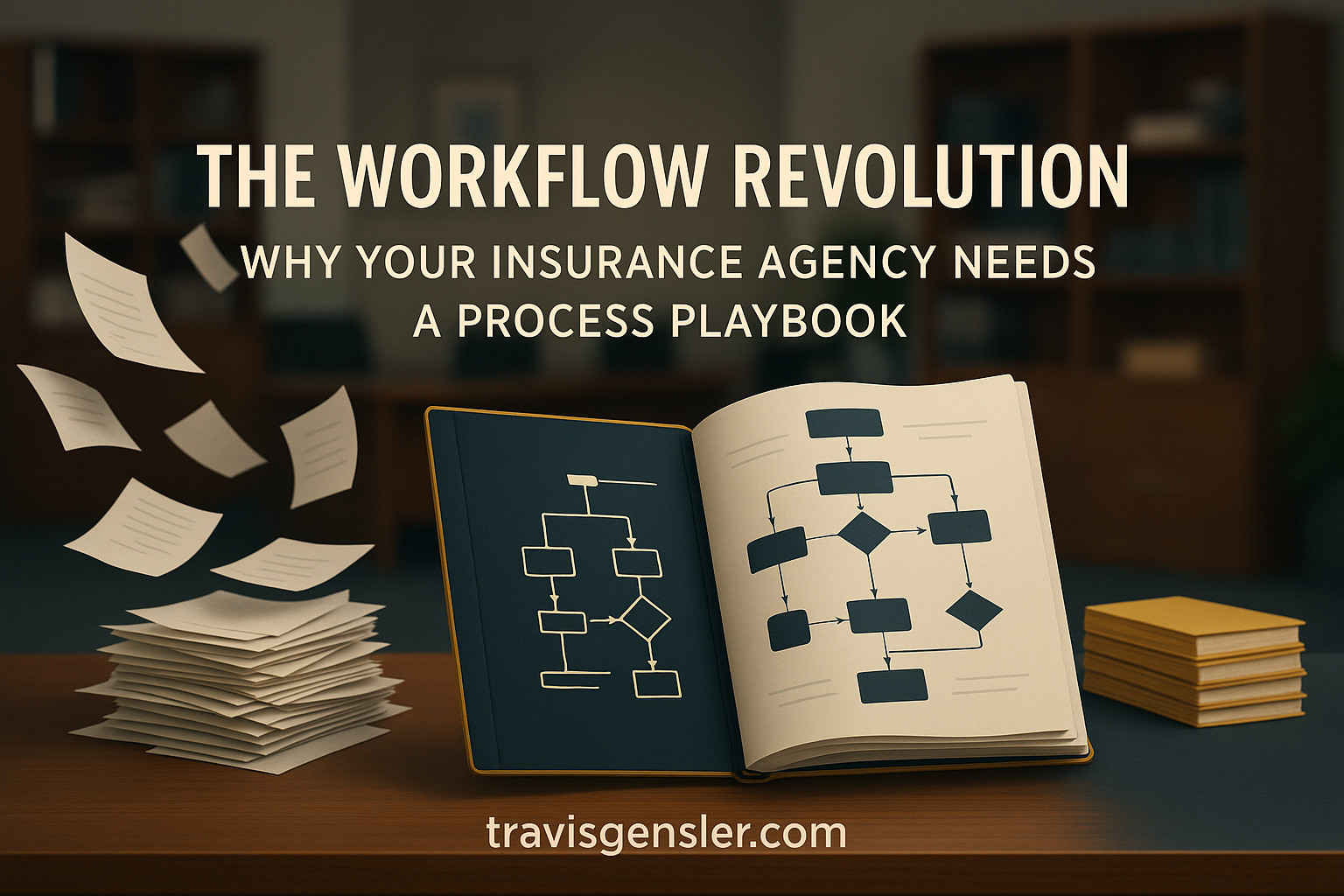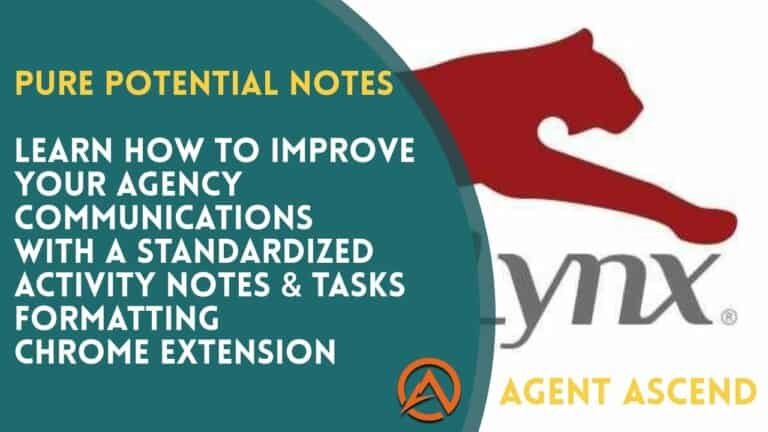Ever noticed how the most successful insurance agencies seem to run like well-oiled machines? While you’re drowning in paperwork and playing email tag with clients, these agencies are smoothly processing claims, renewing policies, and somehow still finding time for happy hour.
What’s their secret? I’ll give you a hint – it’s not superhuman agents or magical technology. It’s something much simpler that most agencies completely overlook: documented workflows.
The Painful Truth About Your Current Process (Or Lack Thereof)
Let’s be honest for a second. Right now, your agency probably handles processes like a game of telephone. Agent A does it one way, Agent B has their “special method,” and that new hire? They’re just trying to figure out which end is up.
This approach might work when you’re a one-person shop operating out of your garage, but as your agency grows, this chaos becomes your biggest liability. It’s like trying to build a house without a blueprint – you might eventually get something with walls and a roof, but I wouldn’t want to be standing in it during a storm.
Why Most Agencies Never Fix This Problem
“But Travis,” you might say, “we’re too busy putting out fires to document workflows!”
And therein lies the greatest irony of the insurance business: the agencies that need documented workflows the most are often the ones too overwhelmed to create them. It’s like refusing to build a fire escape because you’re busy dealing with fires.
The Seven-Figure Difference Proper Documentation Makes
When I consult with insurance agencies, the ones with well-documented workflows consistently outperform their peers. We’re not talking about minor improvements – we’re talking about transformational changes:
Imagine cutting your policy processing time in half. Picture your new hires becoming productive in weeks instead of months. Envision your E&O exposure shrinking faster than a wool sweater in a hot dryer.
These aren’t fantasy scenarios – they’re the reality for agencies that invest in proper workflow documentation. According to insurance industry research, agencies that digitize core processes like underwriting and onboarding can slash administrative expenses by 20-30% and reduce cycle times by up to 70%.
That’s not just efficiency – that’s money directly into your pocket.
The Critical Workflows Every Agency Must Document
If you’re convinced but wondering where to start, here are the absolute non-negotiable processes that need documentation yesterday:
- New Client Applications – From lead capture to policy issuance, this workflow touches every part of your revenue generation.
- Policy Renewals – The lifeblood of your agency’s sustained success, yet often handled with all the strategy of a game of darts.
- Claims Management – The moment of truth in the client relationship, where a smooth process can turn disaster into loyalty.
- Customer Service Interactions – Those daily touchpoints that either build your reputation or slowly chip away at it.
- Quote Generation – The first impression that can make or break your chance at new business.
Each of these processes deserves its own documented workflow, complete with clear steps, decision points, and responsible parties. Think of it as creating a GPS for your team – everyone arrives at the destination, regardless of who’s driving.
How to Create Workflow Documentation That People Actually Use
Let’s face it – most procedure manuals end up gathering more dust than a forgotten corner of your attic. The key to creating documentation that your team will actually reference comes down to three factors:
Make it visual. Our brains process images 60,000 times faster than text. Flowcharts, screenshots, and process maps aren’t just pretty – they’re processed differently by our brains and dramatically improve understanding.
Keep it accessible. If finding your workflow documentation requires an Indiana Jones-style quest, no one will use it. Whether it’s a wiki, a shared drive, or your agency management system, pick one central location and stick with it.
Write for skimmers. Your agents will rarely read your documentation cover-to-cover like a novel. They’ll skim for the exact information they need in the moment. Use clear headings, bullet points, and highlighted key information to make this easy.
The AI Revolution in Workflow Documentation
If you’re thinking “this sounds great but impossible with my current resources,” I’ve got good news. The rise of AI tools has made workflow documentation dramatically easier.
Modern AI can extract data from your existing forms, identify patterns in your processes, and even generate initial drafts of workflow documentation. Tools that would have cost six figures and required dedicated IT staff just five years ago are now accessible to agencies of all sizes.
This isn’t about replacing your team’s expertise – it’s about amplifying it. AI can handle the heavy lifting of organizing information, while your experienced agents provide the crucial context and insights that make the documentation truly valuable.
The Training Superpower You’re Ignoring
Here’s a benefit of documented workflows that most agencies completely overlook: they’re the ultimate training resource.
Think about it – what’s harder than training new insurance agents? Between complex products, regulatory requirements, and agency-specific procedures, the learning curve is steep enough to cause nosebleeds.
Documented workflows transform this process from “follow me around for six months and try to absorb something” to “here’s exactly how we handle policy renewals, step by step.”
The result? New agents who become productive faster, make fewer mistakes, and don’t need to interrupt your top performers with basic questions. That alone can justify the investment in documentation.
Your 30-Day Workflow Documentation Action Plan
Ready to transform your agency but not sure where to start? Here’s your 30-day action plan:
Days 1-3: Identify your highest-impact workflow – typically new client applications or claims processing.
Days 4-7: Map out the current process by interviewing the agents who handle it daily. Document every step, decision point, and potential exception.
Days 8-14: Create your documentation using whatever tools you’re comfortable with – flowchart software, screen recording tools, or even just Word documents with screenshots.
Days 15-21: Have your team test the documentation by following it precisely and noting any gaps or areas of confusion.
Days 22-28: Refine based on feedback and establish a central repository for all team members to access.
Days 29-30: Schedule regular reviews (I recommend quarterly) to keep your documentation current as processes evolve.
The beauty of this approach is that you don’t need to document every process at once. Start with one high-impact workflow, perfect your approach, and then expand. Within six months, you’ll have transformed your agency’s operations.
The Bottom Line
In an industry where margins are tightening and client expectations are rising, operational efficiency isn’t just nice to have – it’s survival. Documented workflows are the single most underutilized tool for insurance agencies looking to scale profitably.
The agencies that embrace this approach will thrive in the coming years. The ones that stick with “that’s how we’ve always done it” will find themselves increasingly unable to compete.
So ask yourself: which type of agency do you want to build?
Until next time, Travis







